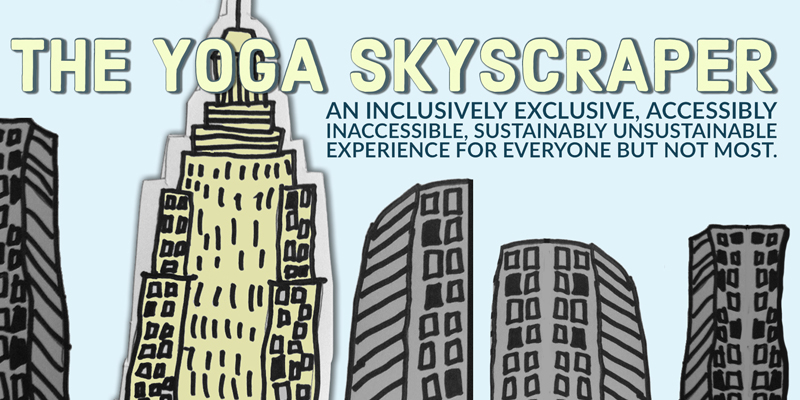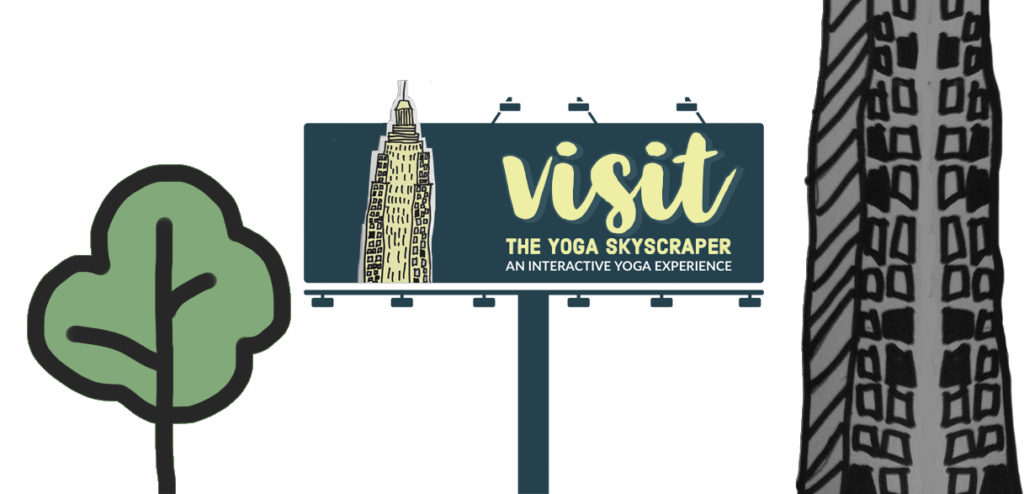
Let me tell you how I ended up in a place where anyone and everyone who shows up to a class can take part fully and gracefully and where no one ever feels left out or singled out so that perhaps you can head that direction too.
It is widely stated that yoga practices are for everyone and anyone. Since becoming a teacher I myself have said those very words plenty of times, but in retrospect despite my best of intentions those statements weren’t entirely true, at least not in relation to the classes that I taught until much more recently.
I’ve frequently discussed the injuries I sustained in relation to practicing yoga publicly. Those injuries were the catalyst for changes in my teaching as well as my own personal practice.
“I looked out and realized how many people were not able to take my classes and how even the people who did attend were often not able to participate fully.”
I was always a very well intentioned teacher and my techniques were often liked as well as praised for being thoughtful and detailed as well as safe and intelligent. What I didn’t know was that they were also highly exclusive and not inherently sustainable to the people who could participate. I didn’t even know that was the case for myself until I was injured. When that happened I looked out and realized how many people were not able to take my classes and how even the people who did attend were often not able to participate fully which I have learned by asking questions and listening, left them often feeling defeated or like they were to blame. That sentiment is shared weekly in the workshops and trainings that I lead around the world which keeps my fire for change alive.
What people may not realize is that I absolutely adore puzzles and riddles, and am driven by a desire to figure out the cause for problems and navigating and developing solutions to them. That personality trait coupled with my personal experience have led me down a path that has allowed me to figure out why classes aren’t as inclusive or sustainable as we say they are and to develop ways to shift the teaching methods and techniques so that the outcome of my classes and the classes of the teachers I work with congruently align with the promises that are made in relation to a yoga practice and group yoga classes.
I’ll use one of my favorite metaphors to help illustrate the situation and how I see solutions. Imagine the tools that are being used to teach yoga (asana & group asana classes) conceptually as if they’re a skyscraper.
Let’s say that a building has been built called The Yoga Skyscraper and it has been constructed to serve the purpose of teaching visitors about yoga’s concepts and the visitors relationship to those concepts. Anyone and everyone that chooses to enter the building is said to be able to participate without barrier no matter what body or set of circumstances they personally have, everyone is welcome.*
Visitors of the building are meant to learn about Yoga while visiting The Yoga Skyscraper by taking a tour of the building. Times are scheduled for groups to enter the building together where they get to explore their own individual relationship to the building’s interior with the rest of the group (yoga classes). Visitors are to guided through the building’s many halls and atriums, rooms and alcoves, basement and roof-deck, and the many other features that the building contains in order to learn what yoga is all about via their direct experience with the building and its contents.

Visitors to the building are guided by The Yoga Skyscraper Group Experience Tour Guide (yoga teacher) who’s voice is broadcasted through the building via the intercom. The Tour Guide moves visitors through the building in a logical order and explains the possibilities and potential that each feature may contain and how the visitor may choose to interact with the contents.
The tour guide is meant to give the visitors enough information about each of the buildings floors, rooms, and features that they can decide what may be important to notice when they’re interacting with the building and how to avoid pitfalls. The tour guides are also meant to help visitors navigate how to move from floor to floor and room to room and how to know if they’re ready to potentially see a new part of the building. Lastly, the tour guide is there to give enough information that the visitors feel secure but not so much that they’re overwhelmed and to make sure that everyone in each group is able to participate and that no one falls down the stairs, gets lost, or left out.
Currently though, The Yoga Skyscraper’s structure has some problems that make it pretty exclusive as well as a bit precarious and it’s making it hard on visitors and The Tour Guide’s alike. The building contains some engineering problems that have caused the city building inspectors to be concerned, stating that the building isn’t very sound or sustainable and doesn’t meet the requirements for people with special circumstances.
The building is also missing elevators and ramps and its doors and halls aren’t wide enough. The steps are incredibly steep and have no hand railings to hold on to. Some of the rooms have ceilings that are way too low, and there are entire floors that are missing fire alarms and sprinkler systems. Some of the floors are also missing a few load baring walls which makes the building precarious and potentially dangerous for anyone and everyone who enters and it makes the Tour Guide’s job often feel daunting and sometime impossible.
Some people have been able to navigate the building without too much issue so they’ve regularly visited the building for years. Despite their ability to access almost the entire structure, some of them have begun to realize that the building it a bit shaky. They also have some aches and pains from having to duck down and stoop in the halls with the low ceilings so often and their knees are aching from climbing the steep stairs. The Tour Guide told them about that potential and offered ways to avoid the aches and pains. They heeded the advice but for some reason they ache and hurt now anyway.
Other people visit the building a lot too but no matter how hard they try, no matter how patient or diligent they are, and no matter how closely they follow along with the tour guides instructions and advice, they still can’t access any area of the building but the lobby and ground floor and it’s rooms. They’ve got some aches and pains from bumping their heads on the ceiling during their efforts
Sometimes visitors come once or twice but they often don’t come back because they find the building is precarious to navigate and many can’t access much more that the lobby and the ground floor of the building so they only get to enjoy a fraction of the contents making it feel like they’re wasting their efforts exploring.
Some people want to see the inside of The Yoga Skyscraper and are interested in what it has to teach them but they’ve seen pictures which show that the building may be difficult or impossible for them to enter or navigate it so they conclude that The Yoga Skyscraper just isn’t meant for them so they stay home.
The Tour Guides are trying really hard to offer an experience to everyone who comes to visit the building whether it’s once or many times, but sometimes they just can’t help people get up the stairs, or through the overly narrow corridors no matter how hard the try. They’ve tried following the recommendations of management and their predecessors but to they still can’t quite accommodate all of the visitors. They’ve even tried going off book a bit by improvising and getting creative but there are still lots of people left out or that bump their heads on the ceiling.
When The Tour Guides go and hang out with their friends and family who haven’t been to The Yoga Skyscraper, some of them say that they feel like the building isn’t for them. The Tour Guides try to assure them that they’re mistaken, but in their gut sometimes they remember seeing someone get stuck at the front door to the building and they know the person has a point but they just don’t know what to do about it.
“We need to remember what The Yoga Skyscraper was built for and who it was built for. It was built to teach yoga to anyone and everyone who wanted to participate in a class and that it was built and intended to last long term.”
There’s a solution though, it’s one I’ve worked on for many years, and it really just means shifting the priorities we place on things. We need to remember what The Yoga Skyscraper was built for and who it was built for. It was built to teach yoga to anyone and everyone who wanted to participate in a class and that it was built and intended to last long term. So if that’s the universal set of priorities then we just need to make sure that it’s built with those intentions as the foundation and that those priorities always get considered first and that they get considered often.
So if Tree pose is a feature in The Yoga Skyscraper that anyone and everyone is meant to interact with and we look at Tree Pose then all we have to do it look at Tree for its universal potentials. To me that means it’s a pose that has more weight in one foot than the other and comes with a few different arm positions that can be chosen. Which means a Tree Pose performed in the way it’s currently depicted is just one way to do it but it’s of no more value than any of the other potential Trees. So a tree that’s meant to have the universal experience of having more weight in one foot that they other means that a tree with the foot on the inner thigh, calf, floor, in a chair with a foot lifted, or laying down with one foot pressed into the wall, or seated with more weight in one foot than the other are all the same if that’s the tree that allows the person to put more weight in one foot than the other and to choose to do something with their arms even if that’s just leaving them where they are or where they feel most comfortable.
Classes can still be physically demanding, they can still be difficult, they can still flow and move, and they can still be fun, it’s just a matter of changing the priorities so that we lead with the ones that we promise and that are the most universal. Then everyone and anyone can participate. And magically I’ve found that working this way allows me to teach students about yoga’s philosophy and purpose and their relationship to it much more clearly and personally.
This is how I ended up teaching individual practices in a group setting where no matter who attends, they’ll be able to get what they showed up for and to participate with grace on a level playing field full of acceptance and compassion and growth.
You can do it too. I’ll happily show you how, that’s what Deconstruct to Reconstruct was designed to do.
*Other barriers to entering exist and have namely to do with other forms of privilege such as financial constraints, trauma, race, and may other circumstances. This piece acknowledges those issues as ones that need to be addressed as well.
Art Inspired by Marz Jr.





